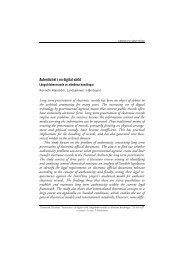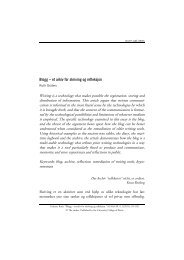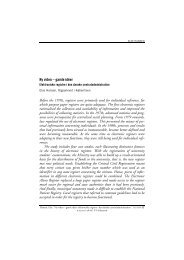The Challenge of Managing Affordances in Computer Game Play
The Challenge of Managing Affordances in Computer Game Play
The Challenge of Managing Affordances in Computer Game Play
Create successful ePaper yourself
Turn your PDF publications into a flip-book with our unique Google optimized e-Paper software.
HUMAN IT REFEREED SECTION<br />
as well as objects. Objects, artefacts, tools – whichever term we use –<br />
constitute parts <strong>of</strong> a culture’s <strong>in</strong>tellectual history (Lave & Wenger 1991;<br />
Rog<strong>of</strong>f 2003; Susi 2006; Susi & Rambusch 2007; Vygotsky 1978), and<br />
the appropriation <strong>of</strong> knowledge about an object’s functionality and its<br />
use <strong>in</strong> games seems to turn the <strong>in</strong>dividual activity <strong>of</strong> perceiv<strong>in</strong>g affordances<br />
<strong>in</strong>to a social process.<br />
In this paper, we specifically want to direct attention to two issues.<br />
<strong>The</strong> first concerns the various uses <strong>of</strong> the affordance concept, and the<br />
second is to show that the affordance concept alone cannot account for<br />
activities such as people’s everyday game play. We may not provide<br />
ready-made answers, but we want to encourage researchers to further address<br />
and reflect upon analytical uses and theoretical conceptualisations<br />
<strong>of</strong> the affordance concept, to avoid replicat<strong>in</strong>g the mistakes made <strong>in</strong>, for<br />
<strong>in</strong>stance, human-computer <strong>in</strong>teraction (HCI).<br />
Please Don’t Confuse <strong>Affordances</strong> with Perceived <strong>Affordances</strong>, 1<br />
or any Other K<strong>in</strong>ds <strong>of</strong> <strong>Affordances</strong><br />
As previously mentioned, computer game play presents a challenge <strong>in</strong> the<br />
sense that players are faced with affordances <strong>of</strong> two different worlds that<br />
need to be <strong>in</strong>tegrated for successful play. Even though players themselves<br />
are unlikely to ever consciously reflect upon “affordances” <strong>in</strong> their game<br />
play<strong>in</strong>g activities, the issue is an <strong>in</strong>terest<strong>in</strong>g one; a good <strong>in</strong>tegration <strong>of</strong><br />
different k<strong>in</strong>ds <strong>of</strong> affordances is also a good <strong>in</strong>tegration <strong>of</strong> the player’s<br />
virtual and real worlds (cf. Gee 2005). <strong>The</strong> challenge manifests itself <strong>in</strong><br />
play situations where the very same object that affords a certa<strong>in</strong> action <strong>in</strong><br />
the real world does not afford the same action at all <strong>in</strong> the virtual world.<br />
A perhaps even greater challenge lies <strong>in</strong> understand<strong>in</strong>g how real world actions<br />
affect actions <strong>in</strong> the virtual world. Before go<strong>in</strong>g deeper <strong>in</strong>to the relation<br />
between real and virtual affordances, 2 however, we need to take a<br />
look at the concept <strong>of</strong> affordance itself, and (some <strong>of</strong> ) its different uses.<br />
Most <strong>of</strong> us have a general understand<strong>in</strong>g <strong>of</strong> the term, but the common<br />
generalness has also lead to a number <strong>of</strong> misunderstand<strong>in</strong>gs and confusions.<br />
Affordance is a useful concept, but if it is to be <strong>of</strong> any real analytical<br />
value <strong>in</strong> computer game research, we need to beware <strong>of</strong> how we use<br />
it.<br />
86









